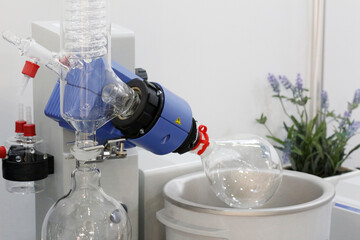In chemistry laboratories, it is very common that reactions, experiments, chemical or even biological procedures are carried out continuously, so it is necessary to have at hand specialized equipment that facilitate the tasks to be performed daily, one of these instruments is known as rotary evaporator or rotary evaporator, widely used both in chemistry laboratories, as in the pharmaceutical industry or in the hospital sector.
A rotary evaporator is a device designed to remove organic or aqueous solvents from chemical samples through evaporation. This instrument has certain characteristics that make it an attractive and indispensable element in any laboratory, for example: it allows to control the temperature at which the sample is stored, solutes can be separated, aromas can be extracted and also, separate solvents that have a low boiling point.
What are the components of a rotary evaporator?
The rotary evaporators have a practical design that allows you to fulfill their operation. Its basic structure is the integration of a motor that allows rotation movement and lifting, a heating plate and distillation equipment. The following are the basic parts of the rotary evaporators:
- Motor: to cause constant rotation of the sample.
- Vacuum pump: to reduce the pressure of the equipment, its use is optional.
- Evaporation flask: where the sample to be evaporated is deposited.
- Bath of Mary: to heat, in a controlled and homogeneous way, the sample to be evaporated. Depending on the sample to be evaporated, the water bath may be filled with water or fuel.
- Condenser: where the evaporation product is returned to the liquid state.
- Harvesting flask: where the evaporation product that was condensing in the condenser is deposited.
- Vacuum gage: not all evaporators have a vacuum pressure gage.
An interesting fact about rotary evaporators is that industrial equipment has the capacity to work with samples of up to 50 liters, a large distillation capacity. This allows demonstrating how useful and practical they can be, both in research in small laboratories and in laboratories of an industrial nature.
How does a rotary evaporator work?
As the name suggests, this equipment evaporates the desired substance by rotating. It consists of a motor which causes the rotation of a round-bottomed flask on which the sample is deposited. In turn, the sample, contained in the flask, is partially submerged in a water bath, at 35° – 45° C, always in constant rotation.
Attached to this are the following devices: a vacuum-proof steam conductor, through which the steam extracted from the sample will pass, a condenser, through which will pass an antifreeze liquid or water to cool the sample, and a flask to collect the extracted liquid, after it condenses.
When using a rotary evaporator, always connect the distillation and melting points of the analytes, in order to avoid overheating of the equipment. It should also be taken into account that the glassware of both the flasks and the evaporation conductor will depend on the type of sample to be evaporated.
Applications of rotary evaporators in chemistry laboratories and others
They are mainly used in the chemical industry, where their application is in the separation of chemicals, solute purification, fractionated distillations of mixtures, organic synthesis and quantification of mixtures, among others. Some of the equipment used in these laboratories also includes vacuum pumps, in order to reduce sample pressure and decrease the boiling point.
In the pharmaceutical industry, they are used to extract components from plants, with which natural medicines can be made. In the molecular kitchen, where these equipments are currently being widely used, they are used to extract the largest amount of water from fruits, this ensures the obtaining of concentrated juices.
What should I consider before purchasing a rotary evaporator?
First you must evaluate the type of sample you will use, the sample is of utmost importance to take into account, since it depends on the type of glassware to be selected. On the other hand, evaluate the temperature at which to work, depending on the temperature at which the sample will be heated, a water bath with water or fuel will be used.
The volume of the sample is another factor to take into account, for large samples, industrial rotary evaporators are needed, while for small samples, laboratory ones are sufficient. The last point to evaluate is the engine, you must evaluate the engine power that will be needed, depending on the sample to be used.
Kalstein brand rotary evaporators
At Kalstein we are MANUFACTURERS of a wide range of laboratory equipment, we have rotary evaporators at the most competitive prices on the market. Our equipment is suitable for evaporation, distillation or chemical separation experiments, with the advantage that they have patented technology of double Teflon Sealing (PTFE) and FV rubber can guarantee the level of negative pressure.
At the time of making your PURCHASE you will have the advantage that you can be in contact with our experts, who will advise you to make your experience satisfactory. To view our catalog, visit HERE . For more information, visit our website HERE

